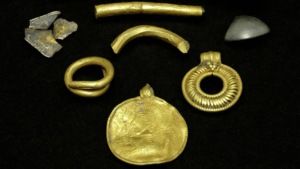News
Iron Age gold jewellery comes back to life on Lolland
This article is more than 3 years old.

Iron Age gold objects have a special significance (photo: Museum Lolland-Falster)
An impressive piece of ancient jewellery has been found on arable land in Lolland.
The gold jewellery, which dates back to the Iron Age, was unearthed in a field in Forneby near Maribo by an amateur archaeologist.
Dazzling pieces of Lolland history
The haul includes four extremely well-preserved pieces of jewellery dating back to the late Iron Age, around 1500 years ago.
And according to Marie Brinch, an inspector at the Museum Lolland-Falster, it is of great archaeological importance.
“Up until the Viking Age, Lolland was a very wealthy society. We have found many tombs where people were buried with gold, silver and precious stones – many of them incredibly beautiful and flamboyant – and this find fits right into that story,” she told DR.
Rare jewels
The two gold medallions are known to archaeologists as ‘brakteater’ and although similar brakteaters have been found previously on Lolland and Falster, these two new finds appear to be the oldest found in the area.
“The two gold medals bear a portrait and a passage that appears to be written in Latin. However, [close inspection reveals] this is pure nonsense and the letters are in fact freely imagined,” said archaeologist Henrik Schilling, a communications consultant at Museum Lolland-Falster .
“If it were a Roman coin, it would have the emperor’s name written on it, but here it makes no sense.”
The jewellery must now be sent to the National Museum, where experts will determine its exact provenance.










































